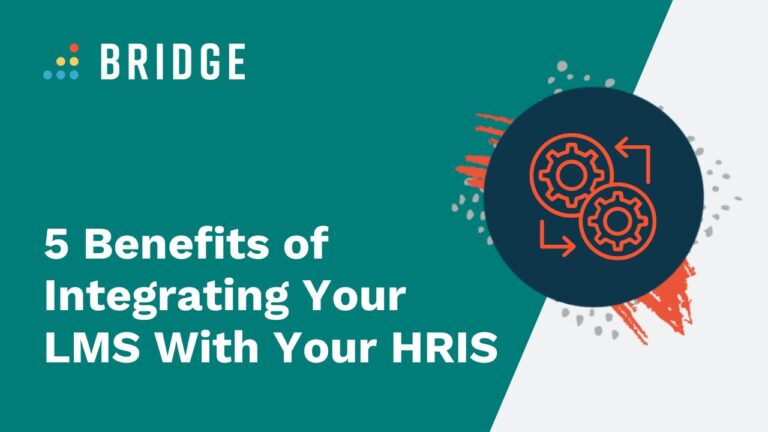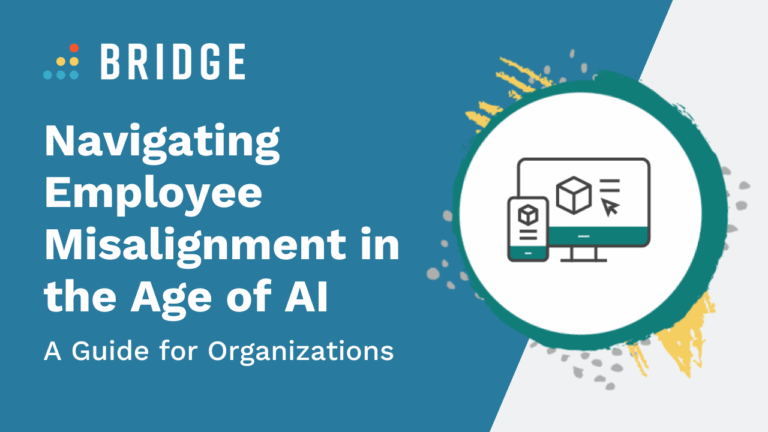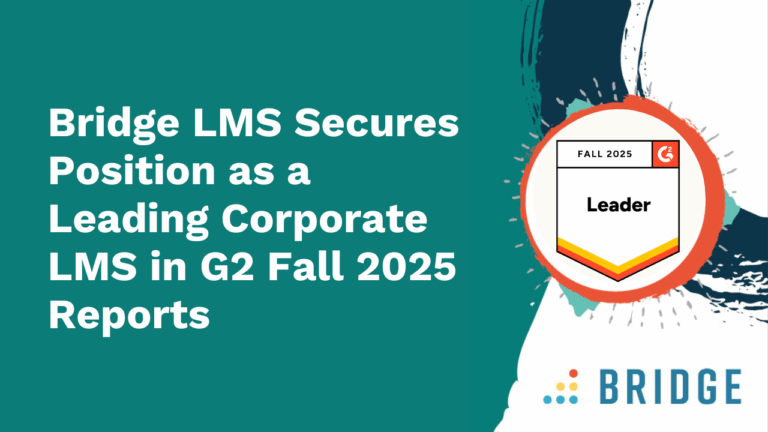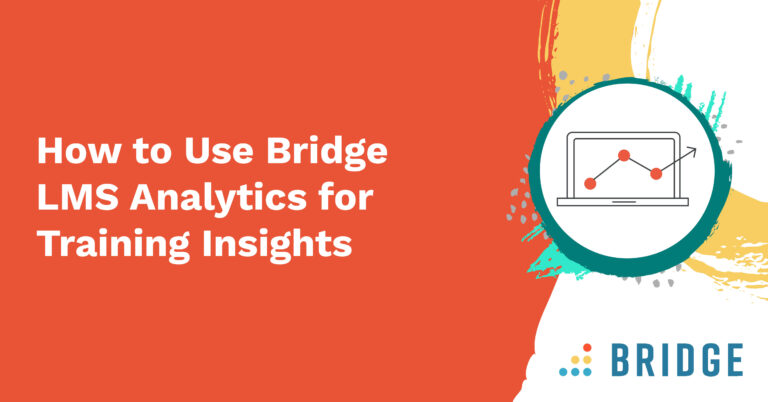Explore the ways your organization can benefit from integrating an HRIS and a dedicated LMS and how to choose a learning platform that meets your training and development needs.
In tough economic conditions, slimming down your tech stack to a handful of carefully chosen tools and platforms can make financial sense. According to a 2023 PwC pulse survey, 89% of HR leaders say finding the right balance between minimizing costs and maximizing growth is a core focus.
What’s also clear is that investing in employee development isn’t optional for organizations looking to retain and upskill their workforce for a stronger future. The same survey indicates that 85% of HR professionals are ramping up investment in skills-based talent and employee development.
Read on as we explore the benefits of integrating a dedicated learning management system with your HRIS and what to look for when choosing a learning platform that leads to more powerful results from training and development programs.
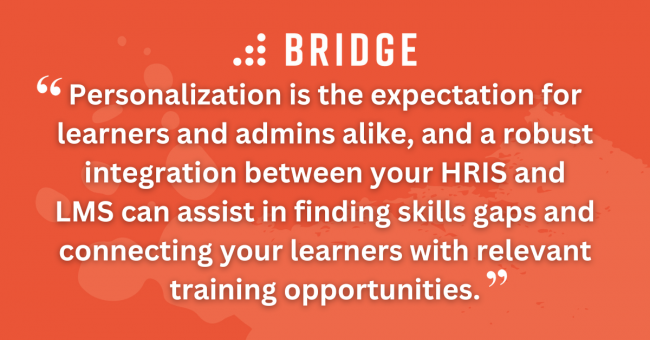
5 Benefits of Integrating Your LMS With Your HRIS
To handle your organization's learning, training, and development requirements, you need a learning platform that seamlessly facilitates HR and LMS integration. Here are some of the key advantages of integrating your systems:
1) Match Employees With Targeted Skills Development Programs
HR professionals say employee career and skills development are the leading factors driving workplace learning within their organization, according to the findings from a Bridge-sponsored report. What's more, for 50%, the top reported benefit of an LMS is its ability to offer employees greater flexibility in choosing where and when they learn.
Personalization is the expectation for learners and admins alike, and a robust integration between your HRIS and LMS can assist in finding skills gaps and connecting your learners with relevant training opportunities.
Your HR platform provides crucial information about employees' past job roles, experience, performance data, and current responsibilities. When you combine this data with learner analytics within your training platform, it’s easier to get a comprehensive view of the full employee.
Plus, in Bridge, you can import data from your HRIS to help you identify skills gaps and recommend training and mentorship programs. By leveraging Bridge's AI-powered skills development capabilities, accessing insights and assigning targeted training takes less manual input. With the power to automatically tag your content with relevant skills based on market research and business goals—and maintain a dynamic job architecture with in-demand roles and skills—you can automate learning recommendations to connect your people with the right training at the right time.
HOW TO DO MORE WITH AI | ‘What’s the Role of AI in Your Talent Management Strategy?’
2) Inform Performance Data With Real-Time Results
Integrating your HRIS with a learning management system and performance management platform like Bridge ties learning and development together more closely.
Combining HR and L&D data gives you a rounded picture of your workforce based on real-time insights, allowing you to target training opportunities and strategically position your talent to meet business needs.
This benefits all levels of your organization—access to individual, team, and business goals and a clear competency framework gives employees the power to track how their training feeds into these goals, monitor their own development, and request feedback.
For managers, increased visibility of data allows them to identify unique employee development needs and track goal progress, leading to more productive and unbiased one-on-ones and performance conversations.
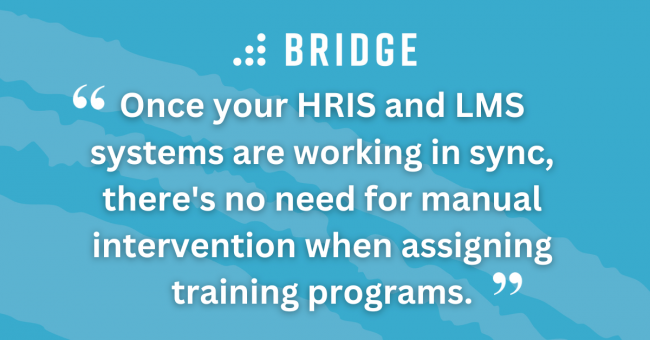
FIND OUT MORE | ‘Power Up Your Performance Management With Bridge’
3) Improve Automation, Data Accuracy, and Security
Data, such as information on organizational structure and job roles, can be automatically synced between your learning platform and HR system. This reduces inaccuracies and redundancies in data, automatically keeps learner data up to date, and secures it within a single cloud-based system.
Within Bridge’s platform, you can segment users and control who sees what content based on your criteria. Defining this information within your HRIS means users will automatically be added and removed from curricula based on predefined categories. Creating a single source of truth between your LMS and HR platform saves countless hours manually inputting data and helps to protect against the consequences associated with outdated compliance training and certifications.
Once your HRIS and LMS systems are working in sync, there's no need for manual intervention when assigning training programs. For example, when a new employee is added to your HRIS, a profile is automatically imported into your LMS along with relevant information, such as department, location, and hire date. This information guarantees that your new starters are fed only the appropriate onboarding materials.
DISCOVER HOW BRIDGE HELPED ADWISE POWER UP ITS LEARNING AND PERFORMANCE STRATEGY | ‘Revolutionizing Employee Development and Performance to Achieve a 97% Staff Retention Rate’
4) Use Advanced Analytics and Reporting to Spot Patterns and Make Predictions
By integrating your HRIS with a training and development platform like Bridge, you can track the impact of learning and skills development in correlation with metrics such as retention rates, employee productivity, and promotions across the company. As such, this can be used to preempt the causes of churn and refine training programs to optimize value.
Sophisticated LMS reporting and analytics tools make it simple to track learner progress, detect gaps in knowledge, and anticipate future training needs. By layering your HR data, you draw a more comprehensive picture of organizational roles and skills that you can use to plan future budgeting decisions, inform succession plans, and place talent effectively.
It's also straightforward to generate and extract reports in visually engaging formats and share them with execs and stakeholders.
MORE WAYS TO LEVERAGE HR DATA | ‘The Power of People Analytics: How to Turn People Data Into Business Results’
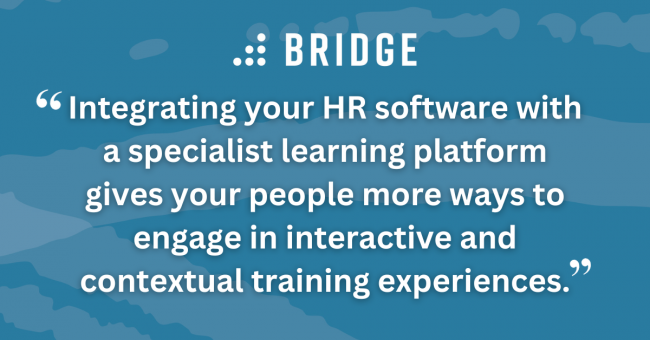
5) Create Engaging eLearning Content to Drive Talent Mobility
Survey findings compiled by CIPD show that L&D professionals who integrate collaborative tools to support peer learning (and use a variety of content formats) are more than twice as likely to say that L&D strategies are closely aligned with organizational goals than those who rely less on tech.
An LMS with content authoring capabilities like Bridge makes it quick and simple to build interactive courses and quizzes, import and embed pre-built SCORM files, and categorize your content within a central self-service portal without extensive technical expertise. Access to a responsive authoring tool is an efficient way to craft and assign mobile-friendly courses for your remote and field learners and swiftly update and distribute content based on policy updates.
Integrating your HR software with a specialist learning platform like Bridge gives your people more ways to engage in interactive and contextual training experiences that strengthen their practical skills and increase knowledge retention. The right platform enables your people to access, share, and comment on a library of training resources. They’ll also be able to collaborate with communities of learners with the same career goals and participate in live training and Q&A sessions via webinars and video-based learning sessions within the LMS.
ACTIONABLE WAYS TO STRENGTHEN THE LINK BETWEEN ENGAGEMENT AND L&D | ‘4 Ways to Fuel Employee Engagement With Skills Development’
5 Questions to Ask When Choosing an LMS to Integrate With Your HRIS
Use the following five questions when choosing an LMS to determine its value to your organization and position it as an investment.
1) Does the Software Provider Specialize In Learning and Development?
Think about the product features you consider most important when choosing software, alongside those that allow you to do your best work.
Look for evidence through customer reviews, testimonials, and industry accreditations to see what others value from software providers and where solutions such as Bridge stand out.
As a top-rated LMS provider, Bridge offers a leading customer experience and demonstrates value and strength of capability in several key areas. In SoftwareReviews’ Emotional Footprint Report, customers shared a range of positive sentiments about Bridge. For example:
- 94% described their service as ‘respectful’ and ‘caring’
- 90% agreed that Bridge enhances performance
- 86% stated they’re satisfied with product enhancements
Hands down the best LMS on the market. As you evaluate LMSs, be thorough with your evaluation of Bridge. It can do pretty much anything you need it to. You just need to know how. Don't let the simplicity of the interface fool you.
Instructional Architect
2) How Long Does Software Onboarding and Implementation Take?
Rolling out a new platform is a complex task, and it can take months to transfer data and get systems live.
Bridge's learning platform can be fully operational in weeks (not months!), meaning that you can rapidly get your training underway. Our technical experts and customer success managers stay in close contact throughout the process to ensure your strategic goals are met according to your project plan.
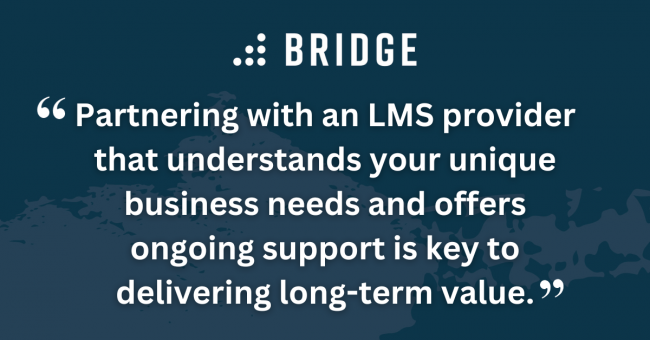
TIPS TO ROLL OUT SOFTWARE WITH EASE | ‘How to Roll Out New HR Software to Employees: 8 Ways to Make Sure Teams Use It’
3) Is There a Cost to Integrate the LMS With Your HRIS?
Look beyond the initial price tag when weighing up solutions, as compromising on quality could cost more time and money down the road.
With Bridge, user data is synced automatically from your HRIS system to the LMS every 24 hours, so there’s no need to manually make updates in your LMS. Your HRIS will remain the source of truth of your core HR data, flowing seamlessly into Bridge.
RELATED READING | ‘Learning Management Systems: The Centerpiece of Your Training Budget’
4) What Level of Customer Support Can You Expect From the Software Provider?
Partnering with an LMS provider that understands your unique business needs and offers ongoing support is key to delivering long-term value.
With a 99.97% customer satisfaction rating, Bridge offers first-class support in the form of:
- 24/7, 365 customer support from in-house specialists
- Access to training for admins and authors, a knowledge base, and roadmap webinars
- Live training videos from a dedicated onboarding team
FURTHER READING | ‘How to Pitch HR Tech to Your IT Team’
5) Is the System Easy for Learners and Admins to Use?
If tech is unwieldy and hard to navigate, keeping your people on top of required training and creating a culture of engaged learners can be challenging.
However, an LMS that’s easy to learn and use for both admins and end-users reduces friction. In fact, when one Bridge customer used the platform to simplify training and performance processes, they saw employee engagement skyrocket and boosted compliance completion to 100%!
Your managers will also be more likely to promote adoption and share the benefits of a system that's enjoyable to use.
How to Integrate an LMS and an HRIS
Combining systems with an HRIS can be technically complex and challenging, as platforms might have different architectures and protocols. Seamlessly integrating HR and L&D systems bridges the gap between your tech stacks and allows for the exchange of data.
Bridge integrates easily with all major HRIS systems (including SAP, ADP, and Workday), creating a seamless flow of data between your technologies. Employees can access the platform using single sign-on (SSO) and authentication, meaning they only need a single account and login to use your HR tools.
If your organization has unique integration requirements, you’ll find that pre-built connectors, webhooks, and APIs can work around your existing tools.
Maximize Your Training and Employee Development Programs With Bridge
Bridge's award-winning LMS (Bridge Learn) and performance management system (Bridge Perform) have helped thousands of organizations worldwide bring employee training and development programs to life by combining learning, skills building, and employee engagement in one easy-to-use platform.
Available as standalone products or as an all-in-one offering, Bridge integrates with all major HRIS platforms, giving you the flexibility, functionality, and ease of use to deliver the full power of your training programs. Get in touch to request a demo and find out more.
